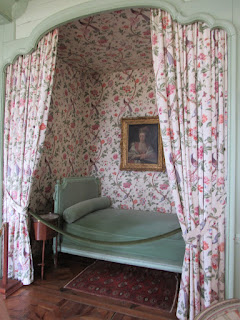
In the 13th century, the fief of Chenonceau belonged to the Marques family. The château was torched in 1412 to punish its owner, Jean Marques, for sedition. Afterward, he rebuilt a château and fortified mill on the same site in the 1430s. Jean's heir, Pierre Marques, found it necessary, however, to sell the château because the rebuilding had incurred heavy and unpayable debts.
Thomas Bohier, chamberlain to King Charles VIII of France, purchased the castle from Pierre Marques in 1513. Most of it was demolished and then rebuilt it 1515-1521 with the 15th-century keep still standing (pointed structure on the left). Bohier's wife, Katherine Briçonnet, oversaw most the work, and built it according to the plans of the Venetian Palazzo. She was the first of the "Ladies" of Chenonceau who played a major role in embellishing the château and its gardens. She especially delighted in hosting French nobility, including King Francis I on two occasions.
In 1535, King François I seized the château from the Bohiers' son for unpaid debts to the Crown. After François' death in 1547, the new king, Henry II, gifted the château to his favorite mistress, Diane de Poitiers. In 1555 she commissioned Philibert de l'Orme to build the arched bridge joining the château to its opposite bank, which made the architecture of Chenonceau unique in all the world. Diane then oversaw the planting of extensive flower and vegetable gardens and a variety of fruit trees. Set along the banks of the river, but buttressed from flooding by stone terraces, the exquisite gardens were laid out in 4 triangles.
Diane
de Poitiers, who was renown for her beauty, intelligence, and sense of
business, was the unquestioned mistress of the castle. Ownership
remained with the crown until 1555 when years of delicate legal
manœuvres finally yielded possession to her.
 photo by François Levalet
photo by François Levalet
Nevertheless, after Henry II died in 1559, his strong-willed Italian-born widow and regent Catherine de Medici forced Diane out and made her agree to exchange Château Chenonceau for the Château Chaumont. Catherine then made Chenonceau her own favorite residence and spent a fortune adding a new series of magnificent gardens, raising the height of the gallery, adding rooms between the chapel and the library, and introducing Italian sumptuousness and glorious parties in order to establish the authority of her son, the young King François II.
Louise of Lorraine married Henry III, Catherine de Medici's other son. In 1589, on the death of her husband, she withdrew to the château and went into mourning. Forgotten by all, she had trouble maintaining her queen-dowager lifestyle since she had devoted her time to reading, charity work, and prayer. Her death marked the end of a royal presence at Chenonceau.
Henri IV obtained Chenonceau for his mistress Gabrielle d'Estrées by paying the debts of Catherine de Medici, which had been inherited by Louise. In return, Louise left the château to her niece Françoise de Lorraine, who at that time was six years old and betrothed to four-year-old César de Bourbon, duc de Vendôme, the natural son of Gabrielle d'Estrées and Henri IV. The château belonged to the Duc de Vendôme and his descendants for more than a hundred years. However, his descendants had little interest in the château. In 1720, the château was bought by the Duke of Bourbon who sold off all of the château's contents. Many of its fine statues ended up at Versailles.
In 1733 the estate was sold for 130,000 livres to a wealthy squire named Claude Dupin. His wife, Louise Dupin, was "an intelligent, beautiful, and highly cultivated woman who had the theatre in her blood." She was an exquisite representative of the 18th century Age of Enlightenment and gave renewed splendor to the château. She started an outstanding salon with the elite among writers, poets, playwrights, scientists, and philosophers such as Montesquieu, Voltaire and Rousseau. She managed to save the château during the French Revolution from destruction because "it was essential to travel and commerce, being the only bridge across the river for many miles."
In 1864 Marguerite Pelouze, a rich heiress from the industrial bourgeoisie, acquired the château and restored it around 1875. The interior was almost completely renewed. However, the costs for these projects--not to mention the elaborate parties--depleted her finances, and the château was seized and sold to Cuban millionaire José-Emilio Terry in 1891. Terry then sold it in 1896 to a family member, Francisco Terry, who had it until 1913. Henri Menier, the family famous for its chocolates, acquired it. The family still owns it to this day.
During World War I, Gaston Menier set up the gallery to be used as a hospital ward. Simonne Menier, the wife of Gaston's son, was in charge of a hospital installed in the château's two galleries, which were transformed and equipped at her family's expense. Over 2,000 wounded soldiers were treated here until 1918. Her bravery also led her to carry out numerous actions for the French Resistance during World War II.






















































